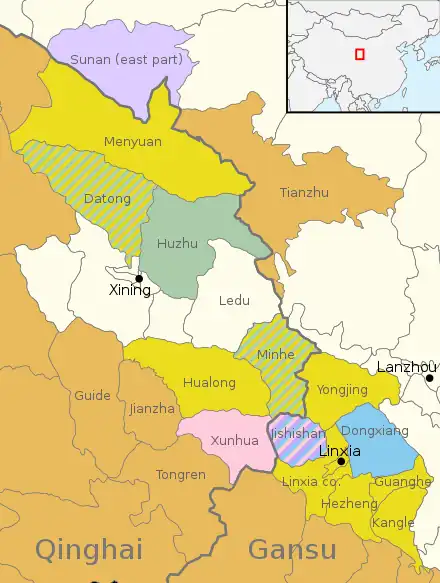The Qinghai–Gansu sprachbund or Amdo sprachbund is a sprachbund in the plateau traversed by the upper Yellow River, including northeastern Qinghai and southern Gansu. This has long been an area of interaction between speakers of northwestern varieties of Mandarin Chinese, Amdo Tibetan and Mongolic and Turkic languages.[1] These families feature contrasting typologies, which spread between languages in the region.[2] The languages have come to share many features, and differ significantly from their relatives outside the region.[3]
Languages

|
Hui
Tibetan
Tu (Monguor)
Dongxiang |
Bonan
Salar
Yugur
|
The languages involved include[4]
- Chinese
- Hezhou, the language of the Hui people in Linxia Hui Autonomous Prefecture (Gansu) and Tongren, Xunhua, Minhe, Ledu and Datong counties of Qinghai.[5][6]
- Gangou, spoken in Minhe county (Qinghai).
- Tangwang, spoken in northeastern Dongxiang Autonomous County (Gansu).[7]
- Wutun, spoken in the Upper and Lower Wutun villages, Tongren county (Qinghai).[8]
- Tibetic
- Amdo Tibetan, the Tibetic language of Qinghai, varies considerably across the region.[9]
- Mongolic
- Monguor (Tu) has two major varieties, often treated as separate languages: Mangghuer in Minhe Hui and Tu Autonomous County and Mongghul in Huzhu Tu Autonomous County.[10]
- Eastern Yugur, spoken in Sunan Yugur Autonomous County (Gansu)
- Bonan (Bao'an) is spoken in Jishishan Bonan, Dongxiang and Salar Autonomous County (Gansu) and Tongren County (Qinghai).[11]
- Santa (Dongxiang), centred on Dongxiang Autonomous County (Gansu)
- Kangjia, spoken in Jianzha County (Qinghai).[12]
- Turkic
- Salar, spoken in Xunhua county (Qinghai)[13]
- Western Yugur, spoken in Sunan county (Gansu)
More mainstream varieties of northwestern Mandarin are spoken in the provincial capitals, Xining and Lanzhou.[9] All these languages are subject to a superstrate influence from Standard Mandarin.[14]
These languages belong to families with three sharply contrasting typologies:
| Chinese | Tibetic | Mongolic and Turkic | |
|---|---|---|---|
| Sentence structure[2] | SVO | SOV | SOV |
| Noun phrases[15] | Adj+N | N+Adj | Adj+N |
| Morphology[2] | isolating | suffixal | suffixal |
| Alignment[15] | accusative | ergative | accusative |
| Phonemic tone | yes | no[lower-alpha 1] | no |
The Mandarin varieties have acquired such features as spirantized voiceless stops, SOV word order and case markers.[16] The Wutun language of Tongren county, Qinghai, is a highly divergent Mandarin variety, with phonological and grammatical structures resembling Amdo Tibetan.[17]
In some cases, the changes progress through the speaker population in a few decades, so that they can be observed in progress. A common pattern is to add a borrowed structure beside an indigenous structure with the same function, after which the indigenous structure loses its function and eventually disappears, leaving a changed syntactic pattern. For example, the indigenous Bonan comparative structure was N-si, where the noun N represents the standard being compared against. Bonan added the equivalent Mandarin structure, bi+N, yielding a composite bi+N-si. The original suffix was then lost, leaving a transformed syntactic pattern.[2]
Notes
- ↑ Some Tibetic languages, including Lhasa Tibetan have developed tonal registers, but these are absent from Amdo Tibetan.[15]
References
Citations
- ↑ Dwyer (1992), p. 161.
- 1 2 3 4 Li (1983), p. 50.
- ↑ Janhunen (2007), p. 85.
- ↑ Janhunen (2012), p. 178.
- ↑ Xu (2014), p. 60.
- ↑ Dwyer (1995), p. 145.
- ↑ Wurm (1995), pp. 59–60.
- ↑ Janhunen et al. (2008), p. 11.
- 1 2 Janhunen (2007), p. 86.
- ↑ Slater (2003), pp. 2–3.
- ↑ Slater (2003), pp. 5–6.
- ↑ Janhunen (2007), p. 87.
- ↑ Slater (2003), p. 11.
- ↑ Dwyer (1995), p. 149.
- 1 2 3 Xu (2014), p. 62.
- ↑ Dwyer (1992), p. 144.
- ↑ Janhunen et al. (2008), p. 7.
Works cited
- Dwyer, Arienne M. (1992), "Altaic Elements in the Línxìa dialect: Contact-induced change on the Yellow River plateau", Journal of Chinese Linguistics, 20 (1): 160–178, JSTOR 23756719.
- ——— (1995), "From the Northwest China Sprachbund: Xúnhuà Chinese dialect data", Yuen Ren Society Treasury of Chinese Dialect Data, hdl:1808/7090.
- Janhunen, Juha (2007), "Typological interaction in the Qinghai linguistic complex", Studia Orientalia, 101: 85–102.
- ——— (2012), "On the hierarchy of structural convergence in the Amdo Sprachbund", in Suihkonen, Pirkko; Comrie, Bernard; Solovyev, Valery (eds.), Argument Structure and Grammatical Relations: A Crosslinguistic Typology, John Benjamins Publishing, pp. 177–189, ISBN 978-90-272-0593-3.
- Janhunen, Juha; Peltomaa, Marja; Sandman, Erika; Xiawu, Dongzhou (2008), Wutun, Munich: Lincom Europa, ISBN 978-3-89586-026-3.
- Li, Charles N. (1983), "Languages in contact in western China", Papers in East Asian Languages, 1: 31–51.
- Slater, Keith W. (2003), A grammar of Mangghuer: A Mongolic language of China's Qinghai-Gansu Sprachbund, Routledge, ISBN 0-7007-1471-5.
- Wurm, S. A. (1995), "The Silk Road and Hybridized Languages in North-Western China", Diogenes, 43 (3): 53–62, doi:10.1177/039219219504317107, S2CID 144488386.
- Xu, Dan (2014), "The role of geography in the northwest China linguistic area" (PDF), in Xu, Dan; Fu, Jingqi (eds.), Space and Quantification in Languages of China, Springer, pp. 57–73, doi:10.1007/978-3-319-10040-1_4, ISBN 978-3-319-10040-1, S2CID 126551898.
Further reading
- Janhunen, Juha (2015), "Describing and transcribing the phonologies of the Amdo Sprachbund" (PDF), Asian Highlands Perspectives, 37: 122–137.
- Kawasumi, Tetsuya, "Shìlùn Hànyǔ Hézhōuhuà de xíngchéng guòchéng" 试论汉语河州话的形成过程 [On the Formative Process of the Hezhou Dialect of Chinese], Diversity and Dynamics of Eurasian Languages: The 20th Commemorative Volume (PDF) (in Chinese).
- Li, Charles N. (1985), "Contact-induced semantic change and innovation", in Fisiak, Jacek (ed.), Historical Semantics – Historical Word-Formation, Moulton, pp. 325–337, ISBN 0-89925-115-3.
- Nugteren, Hans (2011), Mongolic phonology and the Qinghai-Gansu languages (PhD thesis), University of Leiden, hdl:1887/18188, ISBN 978-94-6093-070-6.
- Slater, Keith W. (2021), "Introduction: Language contact in the Amdo Sprachbund", Himalayan Linguistics, 20 (3): 1–7, doi:10.5070/H920355370.